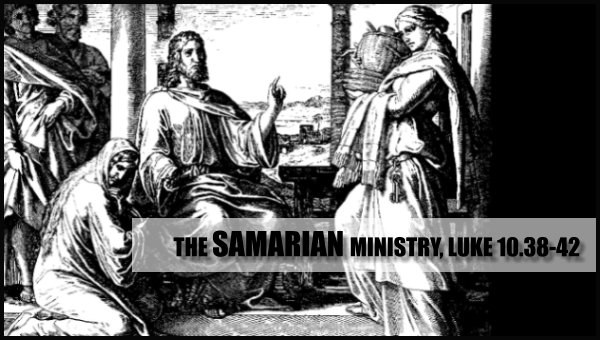By Tyson Thorne

The Samarian Ministry at Various Cities (9.51-18.34), 10.38-42
This story is oddly out of place. We know Jesus has predicted his death – more than once – and that he is now on his way to Jerusalem for the final conflict. Along the way he travels through Samaria, and that in chapter nine, verse 51 Luke tells us Jesus is ministering in Samaria. We don’t have another shift until chapter 18 when we find Jesus leaving Samaria and heading toward Jericho (verse 35). So how is it that Jesus ends up at the home of Mary and Martha, which we know is about five miles east of Jerusalem in Bethany?
Honestly, I’m still looking for a good explanation for this little curiosity. I know that the chronology of events is largely unimportant in ancient Near Eastern cultures. Take Matthew, for example. His gospel contains many of the same accounts as Luke, but in a different arrangement. This is due to the fact that in occidental cultures events may be ordered in such a way as to make a point or prove a supposition; chronological order is a Western construct. For this explanation to hold true, we should be able to discern a running theme in this section of Luke’s gospel that this story supports. Can we do that? I believe we can.
Looking at the way Stephen Langton divided Luke into chapters I believe he saw the same theme that I’ve identified. Who is Stephen Langton? An Archbishop of Canterbury and the man responsible for creating the chapter and verse division in the Bible. The first implementation of the chapters and verses he created was in 1227, and is the same system we have in our Bible’s today. Though not inspired, and in fact are sometimes woefully poor in how they divide texts, they are more useful than not which explains why they are still used. In this case he did a pretty good job, because there is a theme in chapter ten and this account with Mary and Martha is the climax.
Chapter 10 begins with the sending of the 72 disciples. In the instructions Jesus gives he tells them to minister in the cities that welcome them and to leave those that do not. In the parable of the Good Samaritan we see the hero of the story treating the robbed and beaten man with kindness and caring for his needs. In this account with Mary and Martha we observe Martha trying to tend to the needs of her guests while Mary does nothing except listen to Jesus at his feet. What do these three stories have in common? Hospitality.
In this cultural context “hospitality” is defined as kindness shown to a stranger, which matches each of these stories with precision. Even up into modern times hospitality is observed as a moral duty, and Luke pays close attention to this detail in ancient life. Observe the meal at the religious leaders home in chapter seven for an example. This duty was true for the entire region – including Gentiles and Samaritans as well as Middle Eastern nations – not just Jews. There were certain obligations of hospitality for both the host and the guest. In the New Testament we are taught to show hospitality to all people, regardless of their faith, nationality or ethnicity. This moral duty extends beyond the current cultural teaching of “tolerance”; we are to engage and treat respectfully all people not merely tolerate them.
As important as hospitality may be, the point of this passage is that Mary chose what is better. This would have surprised anyone – Jew or Samaritan – as being entertained by the guest was not perceived to be a higher value than serving the guest. And indeed this would not have been the better choice in any other situation; it was that Mary chose to hear and obey the Messiah that made the difference. In light of this it might be worthwhile to consider how we treat Jesus in our lives. Do we show hospitality? Do we serve him? Do we listen and do what he says?
|
|
